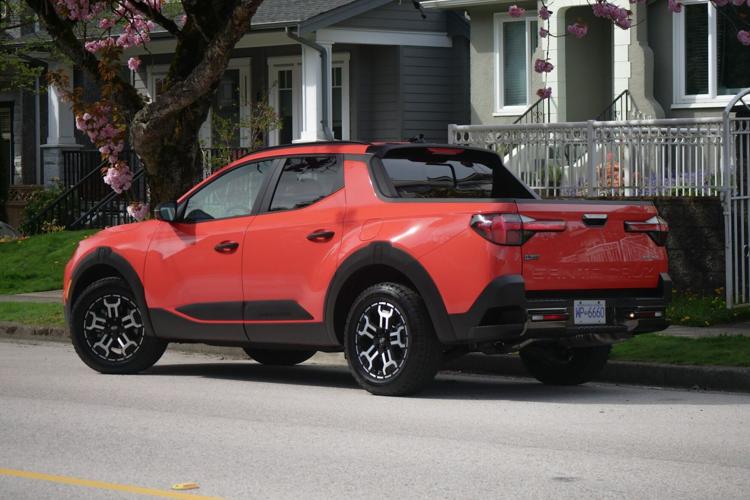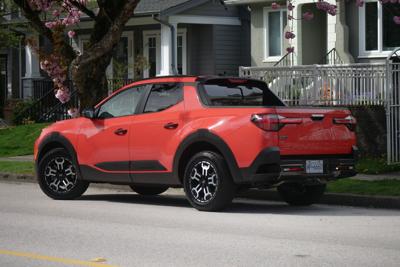Iām driving along through bustling, bumpy city streets. Itās hot outside, itās rush hour and I need to get back in time for dinner. Thereās a lot going on and I’m reflecting on the role the car is playing in all thisĀ ā¦.
The vehicle Iām driving is an able and willing partner. The seats are comfortable, the view out ā forwards, backwards, sideways ā is right on the money and thatās all good. Iām actually surprised by just how easy this is. Why?
Well, it may sound like Iām in a high-riding SUV or crossover, but Iām actually in a pickup truck: the Hyundai Santa Cruz XRT.
While theyāve improved over the years, pickups donāt tend to be the easiest or most comfortable inner-city steeds. The thing about this particular pickup is that its modus operandi is less about hauling job site supplies and more about getting its occupants from A to B in comfort, but with a strong focus on āPā ā practicality.
The Santa Cruz shares its platform with the popular Hyundai Tucson crossover, so it gets a car-like unibody as opposed to a body-on-frame, which provides a quieter and more comfortable ride. Plus, as this is the (slightly) more off road-specific XRT version, it also gets squishy off-road tires and self-levelling rear suspension for even more on-road comfort.
Its bed only measures around four feet, but the fact thereās a bed at all is a big plus for many.
For a person who has been driving crossovers ā or is thinking of buying one ā a pickup bed could be an added carrot for them to consider the Santa Cruz.
Speaking of carrots ā¦ my testerās exterior colour is called āCanyon Red,ā but thereās a distinctly orange hue there; itās a great colour choice for this vehicle which Hyundai is calling a āsports activity vehicleā or āSAV.ā The colour is complimented by neat details such as two-tone, 18-inch wheels with wrench-shaped spokes, contrast-colour roof rails, plastic cladding on the doors, fenders and rocker panels and red tow hooks sprouting from a blacked-out grille flanked by LED DRLs.
Just because the pickup bed is small, donāt think itās bereft of features. It gets a standard rolltop bed cover, lights, cleats, tie downs, extra storage bins on each wall and additional underfloor storage for wet items ā¦ or, as it has drain holes, ice, for drinks. āSports Activity Vehicle,ā indeed!
Inside, the Santa Cruz gets a new digital dash, with dual 12.3-inch displays ā one for the gauges, one for infotainment. Thatās properly modern but, interestingly, theyāve gone slightly more old-school with the climate controls. These used to be controlled via a touch panel without any traditional hard buttons or knobs. For ā25, theyāve delivered a new/old hybrid by keeping some touch-sensitive controls, but adding knobs for your temp adjust as well as volume and tune. Thereās also a band of buttons strung across the top for other media controls such as track seek and navigation map. This system is so much easier to operate while on the move or while using gloves in winter.
The XRT gets navi but it also gets wireless Apple CarPlay and Android Auto if youād prefer to use Google Maps or Apple Maps, plus a wireless charge pad. If youād rather plug in to charge, there are dual USB-C ports for that.
The front cabin is roomy and, in addition to being very comfortable, the front seats come heated and ventilated. However, even though the Santa Cruz is longer than the Tucson, there is less back seat space and no heated rear seat option.
The Santa Cruz comes standard in Canada with a 2.5-litre, turbocharged, four-cylinder engine good for 281 horsepower and 311 pounds-feet of torque, both figures that eclipse whatās on offer from any of the three engines you can get in the Tucson.
The power gets channelled to all four wheels ā AWD is standard ā through a quick-shifting, eight-speed, dual-clutch, automatic transmission. Whether leaving the auto to its own devices or using the wheel-mounted paddles to do the shifting on your own, it works nicely in sync with the engine to provide zippy forward progress that feels quicker than youād expect from a mini-pickup with off-road tires.
The one aspect of the XRT that you want to keep in mind is that, even with all of the tough truck bits it gets, it still doesnāt have a mechanical locking differential and has no more ground clearance than the standard Santa Cruz. The front bumper is shaped for a better approach angle, but itās not really a hardcore off-road vehicle.
So even in XRT trim, the Santa Cruz maintains a more everyday driver bent, but with tons of added practicality afforded by the pickup bed. Yes, its starting price of $44,734 is not cheap, but getting a similarly-equipped Ford Maverick will cost you more and a turbocharged Tucson will cost you about the same. Plus, for many, you canāt put a price on practicality and you canāt put a price on uniqueness, two qualities the Santa Cruz has in spades.
































To join the conversation set a first and last name in your user profile.
Sign in or register for free to join the Conversation